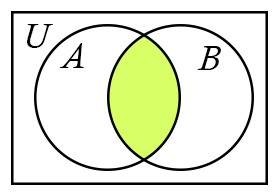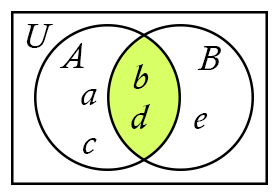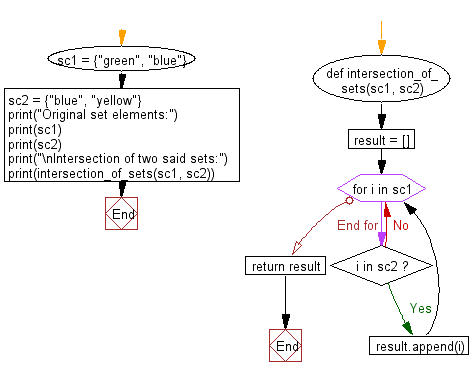Python: Intersection of sets
Python sets: Exercise-6 with Solution
Write a Python program to create an intersection of sets.
In mathematics, the intersection of two sets A and B, denoted by A ∩ B, is the set containing all elements of A that also belong to B (or equivalently, all elements of B that also belong to A).
In set-builder notation, A ∩ B = {x ∈ U : x ∈ A and x ∈ B}.
The Venn diagram for A ∩ B is shown to the right where the shaded region represents the set A ∩ B.

Example: Let A = {a, b, c, d} and B = {b, d, e}. Then A ∩ B = {b, d}. The elements b and d are the only elements that are in both sets A and B.

Sample Solution-1:
Python Code:
setx = set(["green", "blue"])
sety = set(["blue", "yellow"])
print("Original set elements:")
print(setx)
print(sety)
print("\nIntersection of two said sets:")
setz = setx & sety
print(setz)
Sample Output:
Original set elements:
{'green', 'blue'}
{'blue', 'yellow'}
Intersection of two said sets:
{'blue'}
Pictorial Presentation:
Visualize Python code execution:
The following tool visualize what the computer is doing step-by-step as it executes the said program:
Sample Solution-2:
Python Code:
def intersection_of_sets(sc1, sc2):
result = []
for i in sc1:
if i in sc2:
result.append(i)
return result
sc1 = {"green", "blue"}
sc2 = {"blue", "yellow"}
print("Original set elements:")
print(sc1)
print(sc2)
print("\nIntersection of two said sets:")
print(intersection_of_sets(sc1, sc2))
Sample Output:
Original set elements:
{'green', 'blue'}
{'yellow', 'blue'}
Intersection of two said sets:
['blue']
Flowchart:

Visualize Python code execution:
The following tool visualize what the computer is doing step-by-step as it executes the said program:
Sample Solution-3:
Python Code:
setx = set(["green", "blue"])
sety = set(["blue", "yellow"])
print("Original set elements:")
print(setx)
print(sety)
print("\nIntersection of two said sets:")
result = setx.intersection(sety)
print(result)
Sample Output:
Original set elements:
{'green', 'blue'}
{'yellow', 'blue'}
Intersection of two said sets:
['blue']
Visualize Python code execution:
The following tool visualize what the computer is doing step-by-step as it executes the said program:
Python Code Editor:
Have another way to solve this solution? Contribute your code (and comments) through Disqus.
Previous: Write a Python program to remove an item from a set if it is present in the set.
Next: Write a Python program to create a union of sets.
What is the difficulty level of this exercise?
Test your Programming skills with w3resource's quiz.
Python: Tips of the Day
Find current directory and file's directory:
To get the full path to the directory a Python file is contained in, write this in that file:
import os dir_path = os.path.dirname(os.path.realpath(__file__))
(Note that the incantation above won't work if you've already used os.chdir() to change your current working directory, since the value of the __file__ constant is relative to the current working directory and is not changed by an os.chdir() call.)
To get the current working directory use
import os cwd = os.getcwd()
Documentation references for the modules, constants and functions used above:
- The os and os.path modules.
- The __file__ constant
- os.path.realpath(path) (returns "the canonical path of the specified filename, eliminating any symbolic links encountered in the path")
- os.path.dirname(path) (returns "the directory name of pathname path")
- os.getcwd() (returns "a string representing the current working directory")
- os.chdir(path) ("change the current working directory to path")
Ref: https://bit.ly/3fy0R6m
- New Content published on w3resource:
- HTML-CSS Practical: Exercises, Practice, Solution
- Java Regular Expression: Exercises, Practice, Solution
- Scala Programming Exercises, Practice, Solution
- Python Itertools exercises
- Python Numpy exercises
- Python GeoPy Package exercises
- Python Pandas exercises
- Python nltk exercises
- Python BeautifulSoup exercises
- Form Template
- Composer - PHP Package Manager
- PHPUnit - PHP Testing
- Laravel - PHP Framework
- Angular - JavaScript Framework
- Vue - JavaScript Framework
- Jest - JavaScript Testing Framework
